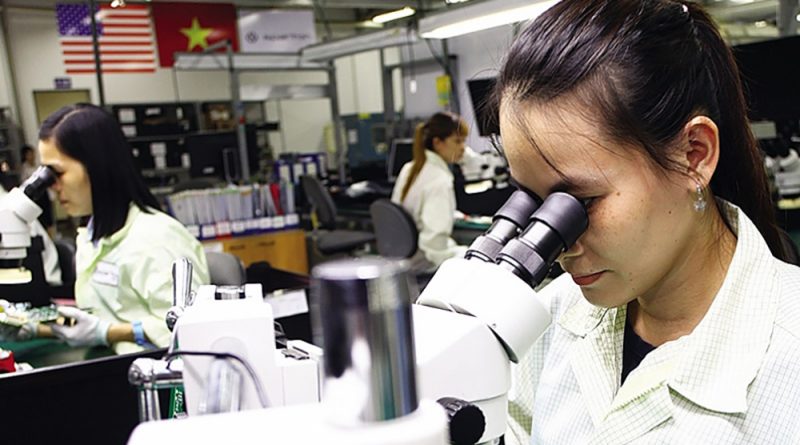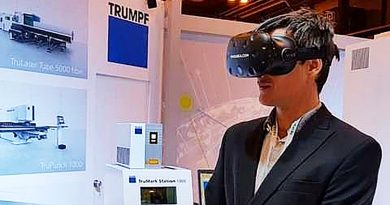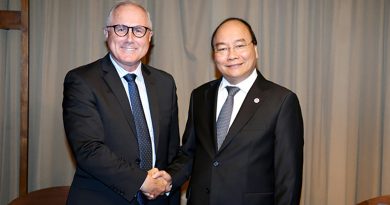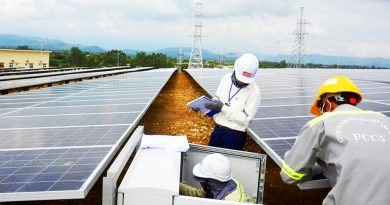Developing a new strategy for FDI
With Industry 4.0 on the rise, Vietnam is looking to change its strategy for attracting foreign direct investment (FDI) to become more selective, with a focus laid on high-technologies. But how can the country reach this goal? Khoi Nguyen reports.
Adam Sitkoff has been living in Vietnam for many years and has witnessed the strong inflow of foreign direct investment (FDI) into Vietnam over the past decades.
As the executive director of the American Chamber of Commerce in Hanoi (AmCham Hanoi), Sitkoff acts as a bridge between US investors and the Vietnamese market, which he sees has great potential, both for high growth and for FDI attraction.
“Business activity here started slowly for Americans. In 1995, US-Vietnam trade stood at just $451 million. It will soon hit $60 billion and we now see US investors active in almost every sector of the Vietnamese economy. American companies have invested billions of dollars here, integrating Vietnam into the global supply chain, creating high-quality jobs, and helping the country become more productive, more efficient, safer, and cleaner,” Sitkoff told VIR.
According to him, it is important to know that while Vietnam’s official investment statistics rank the US not in the top 10, the truth is that the US is one of the biggest investors in Vietnam.
“The misunderstanding comes from complicated US tax laws and corporate structures that utilise global supply chains and systems. For example, Intel’s $1-billion assembly facility in Saigon Hi-Tech Park is an investment made through Intel Hong Kong – so this counts as a Hong Kong investment, even though Intel is an American company,” Sitkoff said. “Another example is P&G’s $100-million factory in Binh Duong, which is an investment made through P&G Singapore – so this counts as a Singaporean investment, even though P&G is a famous American company. There are many examples like this.”
“We believe the United States is one of the top five investors here, and Americans are in Vietnam selling cosmetics, soft drinks and beer, cars, aircrafts, software, industrial goods, educational services, mobile applications, financial and legal services, agricultural products, and so much more.”
Industry 4.0 to lure in FDI
According to World Bank experts in Vietnam, the country is a success story in attracting FDI not only from the US, but from all over the world. In 2016, FDI to Vietnam exceeded inflows into all other ASEAN economies except for Singapore.
As a percentage of GDP, Vietnam’s FDI inflows already exceed those into China or India, and all large ASEAN members except Malaysia. Not content with outperforming most of its regional competitors, 2017 brought Vietnam another record year, with FDI disbursement reaching $17.5 billion.
Data from the Ministry of Planning and Investment showed that registered FDI commitments in Vietnam also nearly doubled over the past four years, from $20 billion in 2014 to nearly $36 billion in 2017.
As of September 20, Vietnam had 26,646 valid FDI projects registered at over $334 billion. In the first nine months of this year, Vietnam attracted 2,182 new foreign-invested projects registered at $14.12 billion. Disbursement hit $13.25 billion, up 6 per cent on-year.
According to the latest figures from Vietnam’s General Statistics Office, foreign-invested enterprises (FIEs) have been performing well in Vietnam over the past years. Specifically, in 2016, their return on sales hit 6.7 per cent, far higher than the average 4 per cent of all enterprises in the economy.
FIEs’ return on assets reached 6.9 per cent, much higher than the average 2.7 per cent of all enterprises in the economy. Also in 2016, FIEs’ net revenue rose the highest, by 34.5 per cent against 2011, accounting for 27.4 per cent of all enterprises’ total net revenue. In addition, though the number of FIEs made up only 0.5 per cent of all enterprises in the economy, they held 28.4 per cent of capital.
However, according to Nguyen Mai, chairman of the Vietnam Association of Foreign Invested Enterprises, despite its major FDI achievements, Vietnam always wishes to attract more US investment, like the Intel or P&G projects that Sitkoff mentioned. This is because these projects are considered high-quality investments, especially as Vietnam is entering the 4.0 era, which creates immense opportunities for the country to change its mindset in FDI attraction and lure global-level investments.
“Vietnam should focus on attracting FDI in high-tech sectors that generate high added value, such as IT, electronics, Internet of Things, and artificial intelligence, as well as virtual reality, augmented reality, cloud computing, and Big Data, along with automation, new materials, education, research and development, and healthcare,” Mai said. “It is critical to say no to polluting projects.”
It has been 30 years since the Law on Foreign Investment was issued in December 1987. FIEs have become an important part of the Vietnamese economy, although some also caused problems, including environmental pollution, outdated technologies, transfer pricing, and technology transfers below expectations.
According to Dezan Shira and Associates, Asia’s largest independent FDI practice, Industry 4.0 is offering numerous opportunities for Vietnam to attract more FDI, especially high-quality investments.
“Investors will continue to find traditional export-oriented sectors such as electronics, garments, and footwear attractive. In addition to the export-oriented sectors, the domestic market also provides an opportunity for investors,” said the firm in a recently released bulletin.
With growing urbanisation and rising incomes, industries such as education, real estate, retail, food and beverages, e-commerce, and fast-moving consumer goods will continue to grow in 2018, the bulletin said. “The aforementioned industries will continue to be a priority for the government in the short term. For the long term, the government is shifting its focus to high-tech and environmentally friendly investments and projects such as renewable energy and high-tech agriculture,” it said.
Recently, with the assistance of the World Bank, Vietnam’s Ministry of Planning and Investment drafted its FDI strategy for 2018-2023, focusing on priority sectors and the quality of investments rather than quantity. The draft aims to incentivise and make it easier for investors to focus on high-tech industries. The initial focus is on four major sectors, namely manufacturing, services, agriculture, and tourism.
To-do lists
Experts from the World Bank and the International Finance Corporation (IFC) – an arm of the World Bank focused exclusively on private sector development – have proposed that in order to attract more high-quality FDI, Vietnam should do many things, including the implementation of a major skills supply push to enable next-generation FDI.
Specifically, the experts told VIR that across sectors, investors cite the lack of industry-ready skills (technical, language, and soft skills) as the greatest barrier to growth. This obstacle is already driving up wage growth. In many sectors, the size of the skills gap is not even known due to insufficient data. Skills supply is arguably one of the most critical impediments in remaining competitive and luring next-generation FDI. Many actions can be taken to reverse this prospect, and they include: (i) launching – and regularly updating – a national survey of supply and demand by discipline; (ii) launching a co-ordinated national programme combining everything from short-term vocational training courses, enhanced industry-academia linkages, and skills-based visas, to long-term curricula reforms and FDI in the education sector by leading global institutions; and (iii) fostering innovation as well as skills, through attracting talent, entrepreneurs, and diaspora from abroad with know-how, ideas, and skills.
The experts also suggested that the government introduce “Investment Climate 4.0” commensurate with business needs in the digital age.
“Industry 4.0 needs a business environment 4.0. Ideally, this environment should be ambitious, moving from ‘playing catch-up’ towards offering a superior investment climate and operating experiences compared to competing locations in the region,” Sebastian Eckardt, the World Bank’s lead economist for Vietnam, told VIR. “Outdated ‘paper-based’ regulations and systems should be replaced with digital/online solutions, and outdated ‘positive lists’ required to qualify for licences/incentives replaced with broad categories of preferred/permitted activities with more limited ‘negative lists.’
“Let us also remove implicit preferences for export-oriented and greenfield FDI as joint ventures. FDI in local supply chains tends to have greater impacts on local value addition and tech transfers,” Eckardtsaid.
According to Sitkoff of AmCham Hanoi, in order for Vietnam to attract higher-quality FDI amid the 4.0 era, the government would need to change its mindset in policy making. “We live in a competitive world. Right now, almost every country in the region is working to grow a modern, digital economy, which will attract future investment and high-paying jobs for their people,” Sitkoff said. “Vietnamese and foreign-invested businesses alike need a supportive environment to thrive, and as you well know, that means their relationship with the administrative agencies should be mutually supportive.”
In his view, US investors remain optimistic about business prospects in Vietnam. However, they remain concerned about recent changes in policy and regulations, which are not consistent with international best practices. These changes expose many investors to considerable risks and obstacles in executing their investments.
“We believe that it is vital that laws and rules be designed to be enforced fairly and equally. Better results in this area will improve investor confidence. Vietnam is a land of great opportunity for foreign investors,” Sitkoff said.
Source: vir.com.vn










